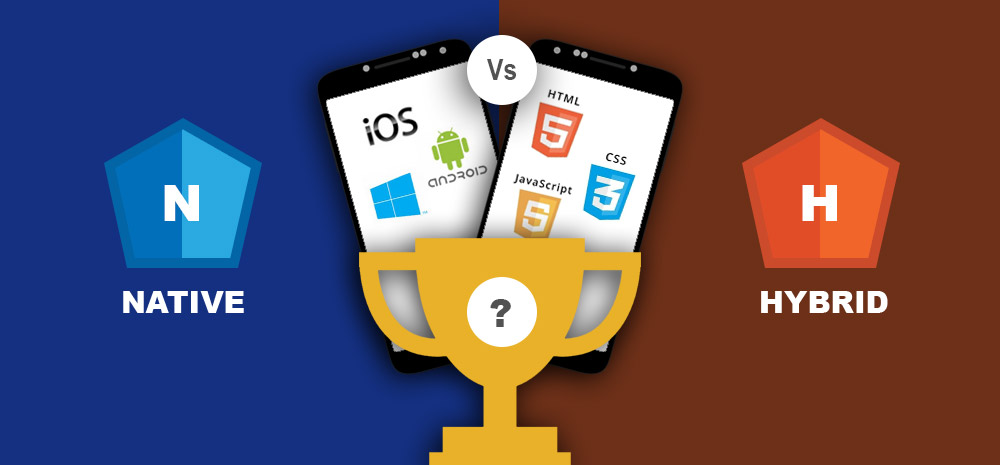Business mobile applications rule the current trends and there are plenty of mobile app developers in Florida. A lot on this topic is still unclear. A business, commercial or professional organization may require development of a mobile application for which it is ready to invest financial resources. But a professional entity which requires the development of a mobile application will have not have the expertise on how the process works or on the variants of mobile apps.
This post aims to illuminate the concepts of native and hybrid development for interested organizations as well as the general reader.
A native mobile application is a smart-phone program that has been created for a particular platform or device such as an iOS, Android or Blackberry. A unique quality of native apps is that users can use some apps without an internet connection.
Hybrid apps are created for use on multiple platforms such as Android, iPhone and Windows phones. They are web applications (or web pages) that can be run in a native browser. Such apps support multiple operating systems at costs lower than developing multiple native
Both native and hybrid apps have various ways of meeting the different needs and purposes of users and developers alike. Choosing between native and hybrid apps will depend on several contrasting factors including budget, targeted audience and deadlines. Each has its own strengths and weaknesses, and the final choice depends on the specific requirements.
| Differences between Native apps and Hybrid apps | ||
|---|---|---|
| Feature | Native Apps | Hybrid Apps |
| Device access | Full | Full |
| Performance | High/Fast | Medium/Good |
| Development Language | Objective C for iOS or Java for Android operating systems | HTMLS, CSS and JavaScript |
| Development Cost | Expensive | Reasonable |
| Development Time | High | Medium |
| Offline mode | Supported | Not Supported |
| Maintenance | High | Medium |
| Speed | Very Fast | Good |
| Cross Platform Support | No | Yes |
| User Interface | Good | Good |
| UI/UX | High | Moderate |
| Advance Graphics | Moderate | High |
| Security | High | Low |
| Code Portability | Low | High |
| Security | High | Low |
| Code Portability | Low | High |
| Complexity | More complex to code | Less complex to code |
| User experience | Better user experience | Less user experience than native apps |
| Graphics | Better graphics | Lesser graphics than native apps |
| Portability | arder to port to other systems | Easier to port to other systems |
| Integration | The camera, address book, geo-location, and other features native to the device can be seamlessly integrated into native apps. | Some device features may be harder to integrate into hybrid apps. |
| Internet Connection | Not Required | Always Required |
| Gesture Support | Yes | Yes |
Write to us at info@sgstechnologies.net or call us at (904) 332-4534 for suggestions on which form of mobile apps will specifically suit your line of business, urgency and budget.

<script type="application/ld+json">
{
"@context" : "http://schema.org",
"@type" : "Article",
"name" : "The difference between native and hybrid application development",
"author" : {
"@type" : "Person",
"name" : "majestic"
},
"image" : "https://www.sgstechnologies.net/sites/default/files/2020-01/nvsh.jpg",
"articleSection" : "Business mobile applications rule the current trends and there are plenty of mobile app developers in Florida. A lot on this topic is still unclear.",
"articleBody" : "A business, commercial or professional organization may require development of a mobile application for which it is ready to invest financial resources. But a professional entity which requires the development of a mobile application will have not have the expertise on how the process works or on the variants of mobile apps.</P>\n\n<P>This post aims to illuminate the concepts of native and hybrid development for interested organizations as well as the general reader.</P>\n\n<P><STRONG>A native mobile application is a smart-phone program that has been created for a particular platform or device such as an iOS, Android or Blackberry. A unique quality of native apps is that users can use some apps without an internet connection. </STRONG></P>\n\n<P><STRONG>Hybrid apps are created for use on multiple platforms such as Android, iPhone and Windows phones. They are web applications (or web pages) that can be run in a native browser. Such apps support multiple operating systems at costs lower than developing multiple native</STRONG></P>\n\n<P>Both native and hybrid apps have various ways of meeting the different needs and purposes of users and developers alike. Choosing between native and hybrid apps will depend on several contrasting factors including budget, targeted audience and deadlines. Each has its own strengths and weaknesses, and the final choice depends on the specific requirements.</P>\n\n<TABLE align=\"center\" border=\"1\" cellpadding=\"20\" cellspacing=\"0\" class=\"table\">\n\t<THEAD>\n\t\t<TR>\n\t\t\t<TH colspan=\"3\" scope=\"col\" class=\"text-center\">Differences between Native apps and Hybrid apps</TH>\n\t\t</TR>\n\t</THEAD>\n\t<TBODY>\n\t\t<TR>\n\t\t\t<TD class=\"text-align-center\"><STRONG>Feature</STRONG></TD>\n\t\t\t<TD class=\"text-align-center\"><STRONG>Native Apps</STRONG></TD>\n\t\t\t<TD class=\"text-align-center\"><STRONG>Hybrid Apps</STRONG></TD>\n\t\t</TR>\n\t\t<TR>\n\t\t\t<TD class=\"text-align-center\">Device access</TD>\n\t\t\t<TD class=\"text-align-center\">Full</TD>\n\t\t\t<TD class=\"text-align-center\">Full</TD>\n\t\t</TR>\n\t\t<TR>\n\t\t\t<TD class=\"text-align-center\">Performance</TD>\n\t\t\t<TD class=\"text-align-center\">High/Fast</TD>\n\t\t\t<TD class=\"text-align-center\">Medium/Good</TD>\n\t\t</TR>\n\t\t<TR>\n\t\t\t<TD class=\"text-align-center\">Development Language</TD>\n\t\t\t<TD class=\"text-align-center\">Objective C for iOS or Java for Android operating systems</TD>\n\t\t\t<TD class=\"text-align-center\">HTMLS, CSS and JavaScript</TD>\n\t\t</TR>\n\t\t<TR>\n\t\t\t<TD class=\"text-align-center\">Development Cost</TD>\n\t\t\t<TD class=\"text-align-center\">Expensive</TD>\n\t\t\t<TD class=\"text-align-center\">Reasonable</TD>\n\t\t</TR>\n\t\t<TR>\n\t\t\t<TD class=\"text-align-center\">Development Time</TD>\n\t\t\t<TD class=\"text-align-center\">High</TD>\n\t\t\t<TD class=\"text-align-center\">Medium</TD>\n\t\t</TR>\n\t\t<TR>\n\t\t\t<TD class=\"text-align-center\">Offline mode</TD>\n\t\t\t<TD class=\"text-align-center\">Supported</TD>\n\t\t\t<TD class=\"text-align-center\">Not Supported</TD>\n\t\t</TR>\n\t\t<TR>\n\t\t\t<TD class=\"text-align-center\">Maintenance</TD>\n\t\t\t<TD class=\"text-align-center\">High</TD>\n\t\t\t<TD class=\"text-align-center\">Medium</TD>\n\t\t</TR>\n\t\t<TR>\n\t\t\t<TD class=\"text-align-center\">Speed</TD>\n\t\t\t<TD class=\"text-align-center\">Very Fast</TD>\n\t\t\t<TD class=\"text-align-center\">Good</TD>\n\t\t</TR>\n\t\t<TR>\n\t\t\t<TD class=\"text-align-center\">Cross Platform Support</TD>\n\t\t\t<TD class=\"text-align-center\">No</TD>\n\t\t\t<TD class=\"text-align-center\">Yes</TD>\n\t\t</TR>\n\t\t<TR>\n\t\t\t<TD class=\"text-align-center\">User Interface</TD>\n\t\t\t<TD class=\"text-align-center\">Good</TD>\n\t\t\t<TD class=\"text-align-center\">Good</TD>\n\t\t</TR>\n\t\t<TR>\n\t\t\t<TD class=\"text-align-center\">UI/UX</TD>\n\t\t\t<TD class=\"text-align-center\">High</TD>\n\t\t\t<TD class=\"text-align-center\">Moderate</TD>\n\t\t</TR>\n\t\t<TR>\n\t\t\t<TD class=\"text-align-center\">Advance Graphics</TD>\n\t\t\t<TD class=\"text-align-center\">Moderate</TD>\n\t\t\t<TD class=\"text-align-center\">High</TD>\n\t\t</TR>\n\t\t<TR>\n\t\t\t<TD class=\"text-align-center\">Security</TD>\n\t\t\t<TD class=\"text-align-center\">High</TD>\n\t\t\t<TD class=\"text-align-center\">Low</TD>\n\t\t</TR>\n\t\t<TR>\n\t\t\t<TD class=\"text-align-center\">Code Portability</TD>\n\t\t\t<TD class=\"text-align-center\">Low</TD>\n\t\t\t<TD class=\"text-align-center\">High</TD>\n\t\t</TR>\n\t\t<TR>\n\t\t\t<TD class=\"text-align-center\">Security</TD>\n\t\t\t<TD class=\"text-align-center\">High</TD>\n\t\t\t<TD class=\"text-align-center\">Low</TD>\n\t\t</TR>\n\t\t<TR>\n\t\t\t<TD class=\"text-align-center\">Code Portability</TD>\n\t\t\t<TD class=\"text-align-center\">Low</TD>\n\t\t\t<TD class=\"text-align-center\">High</TD>\n\t\t</TR>\n\t\t<TR>\n\t\t\t<TD class=\"text-align-center\">Complexity</TD>\n\t\t\t<TD class=\"text-align-center\">More complex to code</TD>\n\t\t\t<TD class=\"text-align-center\">Less complex to code</TD>\n\t\t</TR>\n\t\t<TR>\n\t\t\t<TD class=\"text-align-center\">User experience</TD>\n\t\t\t<TD class=\"text-align-center\">Better user experience</TD>\n\t\t\t<TD class=\"text-align-center\">Less user experience than native apps</TD>\n\t\t</TR>\n\t\t<TR>\n\t\t\t<TD class=\"text-align-center\">Graphics</TD>\n\t\t\t<TD class=\"text-align-center\">Better graphics</TD>\n\t\t\t<TD class=\"text-align-center\">Lesser graphics than native apps</TD>\n\t\t</TR>\n\t\t<TR>\n\t\t\t<TD class=\"text-align-center\">Portability</TD>\n\t\t\t<TD class=\"text-align-center\">arder to port to other systems</TD>\n\t\t\t<TD class=\"text-align-center\">Easier to port to other systems</TD>\n\t\t</TR>\n\t\t<TR>\n\t\t\t<TD class=\"text-align-center\">Integration</TD>\n\t\t\t<TD class=\"text-align-center\">The camera, address book, geo-location, and other features native to the device can be seamlessly integrated into native apps.</TD>\n\t\t\t<TD class=\"text-align-center\">Some device features may be harder to integrate into hybrid apps.</TD>\n\t\t</TR>\n\t\t<TR>\n\t\t\t<TD class=\"text-align-center\">Internet Connection</TD>\n\t\t\t<TD class=\"text-align-center\">Not Required</TD>\n\t\t\t<TD class=\"text-align-center\">Always Required</TD>\n\t\t</TR>\n\t\t<TR>\n\t\t\t<TD class=\"text-align-center\">Gesture Support</TD>\n\t\t\t<TD class=\"text-align-center\">Yes</TD>\n\t\t\t<TD class=\"text-align-center\">Yes</TD>\n\t\t</TR>\n\t</TBODY>\n</TABLE>\n\n<P> </P>\n\n<P>Write to us at <A href=\"mailto:info@sgstechnologies.net\">info@sgstechnologies.net</A> or call us at (904) 332-4534 for suggestions on which form of mobile apps will specifically suit your line of business, urgency and budget",
"url" : "https://www.sgstechnologies.net/blog/difference-between-native-and-hybrid-application-development",
"publisher" : {
"@type" : "Organization",
"name" : "SGS"
}
}
</script>










